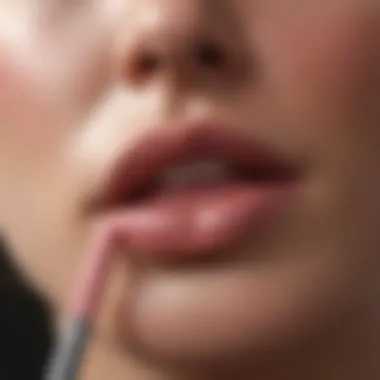Exploring the Ingredients of Lip Gloss


Intro
Lip gloss stands as a staple in the makeup bag of many, a product that brings a dash of shine and a hint of color to lips. But beneath that glossy facade lies a medley of ingredients, each serving a particular purpose. Whether you’re a casual user or a beauty aficionado, understanding what makes up lip gloss can greatly affect your choices. From the hydrating elements to the pigments that give it color, each component contributes to both the performance and safety of this beloved cosmetic.
Beauty Tips and Tricks
When it comes to lip gloss, application and routine can make all the difference. Here are a few tips to ensure you get the most out of your lip gloss:
- Prep Your Lips: Before applying gloss, make sure your lips are smooth. Exfoliating regularly helps keep them soft and prevents any flakes from being amplified by the gloss.
- Layering for Effect: For those who love a bit of flair, consider layering a sheer gloss over a lipstick. This not only gives a multidimensional look but also can enhance the wear time of your colors.
- Use a Lip Liner: To avoid feathering, apply a lip liner that matches your lip gloss. This step adds definition and keeps that glossy perfection in place.
"Lip gloss not only enhances beauty but also protects and moisturizes lips, if made from the right ingredients."
The Ingredients That Matter
Lip gloss formulas often include a combination of the following:
- Waxes: Beeswax and carnauba wax help give structure to lip gloss, allowing it to adhere better without feeling heavy.
- Oils: Coconut oil, jojoba oil, and other emollients keep lips hydrated and add shine. These ingredients are crucial for preventing dryness.
- Pigments: Whether it’s synthetic dyes or natural colorants, pigments give lip gloss its hue while adding personality to the product.
- Flavor and Fragrance: Many glosses contain flavoring agents that can make the product more enjoyable to wear. These can range from sweet vanilla to refreshing mint.
Understanding these components can lead beauty enthusiasts toward products that not only appeal visually but also nourish the lips effectively.
Performance and Safety
When it comes to the safety of lip gloss, it’s crucial to be vigilant about ingredients. Choosing products free from harmful additives, such as parabens or phthalates, can make a significant difference in long-term use. Look for brands that prioritize natural or organic ingredients to ensure that you're not only enhancing your beauty but also protecting your health.
Closure
The construction of lip gloss goes beyond what meets the eye. By delving into the specifics of its ingredients, users can make more informed choices. From the essential waxes to the vibrant pigments, each element plays a vital role. Whether you’re sprucing up your everyday look or preparing for a special event, having a deeper understanding of lip gloss composition will ensure that you choose the product that best suits your needs.
Overview of Lip Gloss
Lip gloss occupies a significant place in the cosmetic realm. More than just a shiny coating for the lips, it serves various aesthetic and practical purposes. Understanding lip gloss is essential for anyone engaged in beauty, whether professionally or personally. With a plethora of formulations available, grasping the nuances of lip gloss can enhance a consumer's ability to make informed choices.
Definition and Purpose
Lip gloss essentially acts as a cosmetic product designed to provide shine, moisture, and color to the lips. Unlike lipsticks, which often deliver full color and can be matte or satin, lip glosses usually focus on glossiness and hydration. The purpose goes beyond aesthetic appeal; many formulations incorporate ingredients that nourish the lips as well. This dual role is particularly appealing for those seeking a more natural look without compromising on lip health.
It's worth noting that the thickness of the gloss can vary. Some may lean more towards a sticky consistency, which can offer longer wear, while others might be lightweight and hydrating, resulting in a more natural feel. The purpose of lip gloss is thus multifaceted. It can elevate a makeup look, offer protection from environmental factors, and provide hydration—all key benefits that make it a staple in many makeup bags.
Historical Context
The history of lip gloss can be traced back centuries, though its image has evolved dramatically over time. Initially, ancient cultures utilized various natural substances to enhance the appearance of their lips. Egyptian women, for instance, often used oils and pigments made from natural ingredients—think of crushed berries or spices—to augment their lips’ color and shine.
Fast forward to the 20th century, and the introduction of commercial lip glosses became prevalent. The late 1930s saw the launch of some of the first modern lip gloss products, which were primarily oil-based. As trends shifted and consumer preferences evolved, formulations advanced. By the 1970s, lip gloss became synonymous with a carefree, youthful look, often favored by the likes of pop stars and cultural icons.
With the emergence of new materials and a greater understanding of skin health, lip gloss has continued to change. Today, one can find everything from high-shine glosses to tinted varieties, catering to diverse preferences and skin types. This evolution not only reflects changing beauty standards but also the growing consumer demand for products that are multifaceted, combining both beauty and health benefits.
Understandably, the broader context surrounding lip gloss is rich. Its journey mirrors societal trends and highlights the intersection between beauty, culture, and innovation.
Key Ingredients in Lip Gloss
The composition of lip gloss is critical in determining its effectiveness, texture, and appeal. By understanding the key ingredients, one can appreciate how these elements contribute to the overall experience of using lip gloss. Each ingredient plays a distinct role, influencing everything from hydration to sheen. This section explores those ingredients in detail, particularly focusing on how they affect the quality and performance of lip gloss.
Base Components
Petroleum Jelly
Petroleum jelly serves as a fundamental component in many lip glosses. Its primary role is to provide a thick, slippery base that creates a barrier on the lips, sealing in moisture while offering a glossy finish. In terms of characteristics, petroleum jelly is notorious for its occlusive properties, which means it traps moisture effectively. This makes it a popular choice among manufacturers looking to enhance the moisturizing capabilities of their products.
However, it comes with a unique feature: it can feel heavy or greasy for some users. This aspect can be both an advantage and a disadvantage depending on personal preference. While many appreciate the lasting hydration it provides, others might find it too thick for daily wear.
Mineral Oils
Mineral oils are another base component often found in lip gloss formulations. They provide a smooth glide during application and enhance the product's spreadability. Characteristically, mineral oils are non-comedogenic, which means they won't clog pores, making them suitable for various skin types. They also help in imparting a longer-lasting shine to the lips, which can be seen as a significant bonus for those seeking a brilliantly glossy look.


Yet, some manufacturers have moved away from mineral oils due to concerns about sustainability and sourcing, sometimes opting for more natural alternatives instead. Thus, the debate continues about their place in modern formulations.
Waxes
Waxes are the backbone of lip gloss formulations since they contribute to its stability and help maintain the desired consistency. Commonly used waxes include beeswax and carnauba wax. The key characteristic of these waxes is their ability to complement the glossy finish by adding a slight firmness while still allowing flexibility.
Waxes do have their unique features, such as their natural origins which can appeal to an eco-conscious audience. Still, there can be trade-offs; for example, the more wax added, the more matte the finish may become. It's a balancing act that formulators masterfully navigate to achieve the perfect gloss.
Emollients
Natural Oils
Natural oils, such as coconut or jojoba oil, have gained popularity for their nourishing qualities. They serve as emollients, softening the lips while offering light hydration. A significant characteristic is their ability to impart a pleasant feel without being overly heavy. This makes natural oils a favored choice among those who prefer a more lightweight and hydrating lip gloss experience.
The unique feature of natural oils lies in their skin-friendly properties and the fact that they often come packed with antioxidants. However, they can vary greatly in quality and efficacy, making sourcing from reputable suppliers essential for consistent performance.
Synthetic Alternatives
On the other hand, synthetic emollients, such as isopropyl myristate, can also be found in lip gloss. These have the advantage of providing a smoother texture and helping the gloss adhere better to the lips. The key characteristic is their lightweight feel, which many users find appealing because it doesn’t weigh down the lips.
However, one noteworthy concern is that synthetic ingredients often face scrutiny from conscious consumers. While they can deliver consistent results, some users prefer products made entirely from natural sources, complicating their acceptance in certain segments of the market.
Colour Agents
Dyes
Dyes are pivotal in giving lip gloss its vibrant hues. They are particularly effective for creating bold and vivid colors that attract users' attention. Dyes are often made from synthetic sources, making them easily adjustable in terms of intensity and shade.
A noteworthy advantage of dyes is their consistency in producing similar colors across various batches. Nevertheless, concerns about the long-term effects of synthetic dyes can affect consumer choice, prompting brands to explore natural colorants as alternatives.
Pigments
Pigments are solid color particles that impart opacity and depth to lip gloss. Unlike dyes, which dissolve for color, pigments sit on the surface, creating a more textured appearance. A key advantage of pigments is their broad spectrum of color options, allowing formulators to craft a diverse array of shades.
However, they can pose challenges; for instance, achieving a smooth application with high pigmentation levels sometimes requires extra formulations to prevent streaking. Thus, the right balance is critical for an appealing finish.
Fragrance and Flavoring Components
Natural Extracts
Natural extracts, such as vanilla or peppermint oil, are often used to add pleasant scents or flavors to lip gloss. These components not only enhance the sensory experience but can also contain beneficial properties, such as soothing effects on the lips. The key characteristic is their ability to offer a flair of freshness without overwhelming synthetic scents.
Their unique feature is the holistic appeal they bring to lip care, drawing consumers who prefer a natural aesthetic. However, some users may have sensitivities to certain natural extracts, making it essential to clearly label these components in products.
Synthetic Flavors
On the flip side, synthetic flavors provide consistency and a wide range of choices. They can replicate flavors that may be difficult to extract from natural sources. A notable advantage of synthetic flavors is their stability; they do not degrade easily over time, assuring manufacturers of a consistent flavor experience throughout the product’s shelf life.
Despite their benefits, synthetic flavors often face backlash from consumers who prefer natural ingredients, leading brands to reconsider their formulas to cater to evolving preferences.
Understanding the complex composition of lip gloss is essential for making informed choices, especially for enthusiasts aiming to select products that align with their value systems.
The Role of Additional Ingredients
In this realm of beauty and skincare, the focus often zeroes in on the primary ingredients that create lip gloss. Yet, the additional components play a pivotal role that is worth parsing out. These ingredients can enhance the product’s stability, texture, and overall experience when applying the gloss. The synergetic relationship among various substances works together to ensure that the product performs not just adequately, but excellently.
Preservatives
Function and Importance
Preservatives might not be the first thing that comes to mind when you think of lip gloss, but they are crucial for maintaining product longevity. Their chief function is to prevent microbial growth and preserve the integrity of the formula over time. This is essential, as lip gloss is often subjected to both air and moisture, creating an environment where bacteria could flourish.
Not only do preservatives help in extending the shelf life of the product, but they also contribute to safe usage for consumers, allowing beauty enthusiasts to enjoy their gloss without concerns of contamination. Without this delightful safety net, lip gloss could become a breeding ground for germs, which we'd definitely want to avoid!
Some of the most well-known preservatives fall under the umbrella of parabens, but there are alternatives that shine in the spotlight as cleaner options. Consumers today often lean towards products labeled paraben-free, as there are still ongoing debates about their safety. Therefore, finding the right preservative can enhance both the simplicity and effectiveness of the formula without compromising safety.


"Preservatives are the unsung heroes of cosmetics, ensuring that your favorite lip gloss remains fresh and safe to use."
Common Types Used
When considering common types of preservatives, a few names tend to surface repeatedly in ingredient lists. Benzyl alcohol and phenoxyethanol are two noteworthy contenders. Benzyl alcohol is not only a preservative but also a solvent, used to improve the texture of the product while simultaneously preventing spoilage. Then there’s phenoxyethanol, which is also celebrated for its broad antimicrobial activity.
These preservatives are popular precisely because they have minimal impact on the product's scent and color, preserving the integrity of the lip gloss’s intended aesthetic. However, it's essential to keep in mind that some individuals may have sensitivities or allergies to these substances, making it crucial for brands to provide clear ingredient listings.
Thickeners and Stabilizers
Commonly Used Thickeners
When it comes to achieving the perfect mouthfeel and viscosity of lip gloss, thickeners come into play. They are vital for ensuring that the gloss does not feel too runny or greasy upon application. One of the most commonly used thickeners in the beauty industry is carnauba wax. Obtained from the leaves of a Brazilian palm tree, carnauba provides a firm texture that enhances the gloss’s hold on lips while imparting a smooth finish.
Another contender is xanthan gum, often favored for its ability to stabilize ingredients while adding body to the formulation. The unique feature here is that xanthan gum is derived from fermentation processes, appealing to those seeking more natural components in their beauty products. While these thickeners work wonders in creating that silky texture, they can also present a challenge if overused, leading to a product that feels too heavy or tacky.
Effects on Texture
The effects of thickeners and stabilizers extend beyond just consistency. They significantly impact the overall user experience. A well-formulated lip gloss should glide effortlessly on the lips, not leaving behind a sticky residue. The balance is delicate; if the formulation skews too thick, it could lead to an uncomfortable feel, while being too thin may cause it to slide off too easily.
The use of stabilizers also plays a role in keeping the formula well-blended. Natural-emulsifiers like sunflower lecithin can be used, helping to maintain a uniform mixture that prevents separation. The right blend results in lip gloss that not only looks appealing but performs exceptionally well — providing shine without clogging the lips.
Ultimately, understanding the role of thickeners and stabilizers in lip gloss can illuminate how crucial these additional ingredients are. The right formulation can create both a satisfying texture and an enjoyable wearing experience, transforming the everyday act of applying lip gloss into a delightful ritual.
Formulation Variations
Formulation variations play a crucial role in the overall understanding of lip gloss. They encompass the various types of lip products ranging from sheer glosses to rich balms and delicate tints. Each formulation not only serves different aesthetic purposes but also caters to varied user preferences and needs. The primary focus here is on how these different formulas impact wearability, hydration, and the sensory experience while applying lip products. This understanding helps consumers make informed choices about products that align with their skincare goals and lifestyle.
Glosses vs. Balms vs. Tints
When it comes to choosing lip products, distinguishing among glosses, balms, and tints is fundamental. Glosses are designed to offer significant shine and often come in vibrant colors. They may be lightweight but can sometimes be sticky, providing a luscious coat that attracts attention.
On the other hand, balms are typically creamier and contain nourishing ingredients. They are less about high-impact color and more about hydration and protection for the lips. When one thinks of balms, brands like Burt's Bees come to mind, emphasizing the soothing power often derived from natural elements like beeswax and shea butter.
Tints bridge the gap between glosses and balms. They provide a hint of color without the thickness of a gloss or the overall moisturizing effect of balms. Their lightweight formulation makes them ideal for day-to-day use, especially when a splash of color is desired without the glossiness.
Custom Formulations for Different Needs
Moisturizing Formulas
Moisturizing formulas are particularly aimed at enhancing lip comfort. The key aspect of these formulas is their ability to deliver hydration and maintain lip health. This is achieved by incorporating emollients and humectants that hold moisture, creating a barrier against environmental dryness.
What distinguishes moisturizing formulas from the rest is their rich composition, often including natural oils like coconut oil or almond oil. These ingredients not only moisturize but also add to the overall smoothness upon application. Such products are favored during colder months when chapped lips become an unfortunate reality. They're a beneficial choice for anyone seeking that added comfort, especially those with sensitive or dry skin.
The unique feature of these products is their dual approach—they not only offer color or shine but also care for the lips. However, they may not offer the same staying power as some glosses or tints. This trade-off is often worth it for those prioritizing skin health over longevity.
Long-Lasting Options
Long-lasting options in lip gloss formulations aim to provide wear that goes the distance. They are specifically engineered to adhere to the lips for extended periods without the frequent need for reapplication. This is a significant benefit for anyone leading a busy lifestyle, as it minimizes the hassle of touch-ups throughout the day.
The backbone of these formulas often lies in stronger-film formers and waxes that create a durable coat. Brands like MAC or Maybelline often showcase such products that balance pigmentation and endurance effectively.
However, although long-lasting lip glosses are convenient, they may come with a price. The formulation might be less forgiving on delicate lips and can sometimes feel drier as they set. Some users find that they may need to prep their lips with a balm to ensure comfort throughout the day.
In summary, both moisturizing and long-lasting formulas offer unique advantages, reflecting distinct needs within the broader landscape of lip gloss products. Understanding these variations can significantly enhance a user’s experience and satisfaction with their cosmetic choices.
Safety Considerations
When it comes to applying lip gloss, safety considerations play a crucial role that can’t be brushed aside. This section will highlight why it matters and how various aspects influence users' experiences, not to mention their health. The potential for dermal reactions, allergies, and overall safety compliance can heavily affect one’s decision-making process when choosing lip products. Ensuring that products meet regulatory standards and are formulated without known allergens can enhance consumers' confidence and satisfaction.
Regulatory Standards
Regulatory standards are the backbone of product safety in cosmetics. Governed by various governing bodies such as the FDA in the United States, these standards outline what can and cannot be included in lip formulas. It's not just about what looks or feels good; it's about what is safe for the mouth, where products get licked, swallowed, and absorbed.


Lip gloss manufacturers are required to follow specific guidelines to ensure their products don't contain harmful substances. Ingredients like parabens or toxic heavy metals are red flags that consumers have become more educated about. These regulations aim to ensure that a product is safe for not only daily use but also long-term application.
"Understanding the regulatory landscape can empower consumers to make informed decisions about their cosmetic use."
Moreover, keeping abreast of regulatory updates is paramount for both manufacturers and consumers. This allows for quick adjustments in formulations if new information comes to light regarding certain ingredients.
Common Allergens and Sensitivities
Identifying Problematic Ingredients
Identifying problematic ingredients is key for users who may have sensitive skin or allergies. For instance, common allergens like certain artificial colorings or fragrances often find their way into lip gloss. An ingredient that might cause a reaction in one person may be perfectly fine for another. The unique feature of being able to pinpoint these ingredients can save a beauty enthusiast from an uncomfortable experience, such as dryness or inflammation.
This aspect is indispensable for consumers seeking lip products that provide comfort without the risk of unwanted reactions. For example, switching to a product that avoids common irritants can be seen as both a beneficial and popular choice among those with sensitive skin. By being aware and vigilant, one can delve into a multitude of options that align with their skin's needs.
Options for Sensitive Skin
Options for sensitive skin are becoming increasingly prevalent, as more brands recognize the need for formulations that cater specifically to this demographic. Made with gentle, soothing components, these products prioritize user comfort without sacrificing the glossy finish.
Such options often include organic oils or plant-based waxes that impart moisture while keeping potential allergens at bay. These formulations’ unique feature is their ability to nourish the lips rather than just superficially cover them with shine.
The advantage of choosing these targeted lip glosses isn't just comfort; it's the peace of mind that comes with knowing you're using a product designed with your skin's sensitivities in mind. Though these formulations might come at a premium, the investment in one's skin health is invaluable.
All in all, safety considerations regarding lip gloss are multifaceted yet essential. Understanding the regulatory framework and being able to identify problematic ingredients can create a safer, more enjoyable cosmetic experience.
The Impact of Environmental Factors
The exploration of lip gloss’s formulation isn't limited to just its ingredients. A significant aspect that shapes the production of lip gloss today lies in the environmental factors surrounding it. As beauty enthusiasts become more conscious of their choices, marketers and manufacturers are stepping up—looking to produce items that are not only appealing but also environmentally sound. Understanding these impacts is essential, as it intertwines with consumer values, manufacturing practices, and the potential effects on the planet.
Sustainability in Lip Gloss Production
Sustainability in lip gloss production refers to methods and practices that minimize environmental damage while maximizing product efficiency. For beauty enthusiasts, this is crucial. If we analyze the state of our planet, we see why consumers demand change. Traditional production methods often involve materials that harm ecosystems, from sourcing to disposal. By shifting to sustainable practices, manufacturers align their goals with those of eco-conscious consumers. This is not just good marketing; it speaks to a burgeoning need for responsibility in an industry historically criticized for its environmental footprint.
Eco-Friendly Ingredients
Amid the surge of interest in sustainability, eco-friendly ingredients have emerged as a frontrunner. These materials are designed to reduce toxicity and environmental harm while still providing an appealing product. Let's filter this down into two specific areas of interest: biodegradable alternatives and recycling packaging efforts.
Biodegradable Alternatives
Biodegradable alternatives represent a paradigm shift in cosmetics formation. These ingredients break down naturally, minimizing long-term waste in landfills. The critical characteristic of biodegradable options is their ability to dissolve back into the environment without leaving harmful residues behind. Many brands are opting for these substances, showcasing a dedication to greener practices.
- Key Feature: Ease of decomposition. Traditional lip gloss can linger in the environment for decades. In contrast, biodegradable variants might return to nature in mere months.
- Advantages: Not only do they lessen waste, but they also appeal to consumers who are increasingly aware of their environmental footprint.
- Disadvantages: Despite their benefits, these ingredients can sometimes be more costly, which might deter some brands from fully transitioning.
This discussion about biodegradable alternatives reflects a broader conversation within the cosmetics industry about sustainability. Brands that invest in such alternatives often gain favor among a discerning clientele that values transparency and eco-sensitivity.
Recycling Packaging Efforts
Recycling packaging efforts represent another critical avenue by which manufacturers can demonstrate their commitment to sustainability. Unlike common beliefs that recycling is merely an afterthought, many companies are revamping their entire packaging strategies to prioritize reusability and recycling programs.
- Key Characteristic: Innovative design. A significant shift in lip gloss packaging involves using materials that can be recycled effectively. This not only includes the containers but also any accompanying packing material.
- Advantages: Adopting recyclable materials can significantly reduce waste, offering users a manageable way to dispose of their products without harming the environment.
- Disadvantages: However, sourcing truly recyclable materials can be expensive and sometimes limits design creativity.
"Shifting to eco-friendly practices not only appeals to the environment but also customers keen on making educated decisions."
Understanding these environmental factors is vital for the future of lip gloss production. As the conversation continues, both consumers and brands must navigate this complex landscape, prioritizing choices that speak to their values while ensuring the efficacy and appeal of their beloved lip gloss.
Trends in Lip Gloss Products
In today’s rapidly changing beauty landscape, understanding trends in lip gloss products offers invaluable insights into consumer preferences and industry innovations. Lip gloss has evolved significantly, providing not just shine but also a range of benefits that cater to diverse needs. These current trends reflect broader societal shifts, responding to the demands of increasingly knowledgeable consumers.
Innovations in Formulations
Recent years seen remarkable advancements in lip gloss formulations. Brands are now not just focusing on the aesthetic appeal of gloss but also emphasizing benefits like hydration, long-lasting wear, and enhanced pigmentation. For example, many lip glosses now incorporate hyaluronic acid, which helps maintain moisture and provides a plump appearance to lips. This shift towards multifunctional products is not only about providing color but also about addressing common issues such as dryness or sensitivity. Moreover, there is a distinct movement towards vegan and cruelty-free products, appealing to conscientious consumers who prioritize ethical considerations in their beauty choices.
Cultural Shifts in Usage
From Subtle to Bold Looks
The transition from subtle to bold looks in lip gloss usage speaks volumes about evolving beauty standards. Historically, lip gloss was often seen as a low-maintenance, everyday product with natural shades being the norm. However, the trend has shifted towards statement colors—think vibrant reds, deep plums, and even metallic tones. This bold approach allows individuals to express their personality and mood through eye-catching hues. An important aspect of this dynamic is the growing acceptance of bold colors in various contexts, whether at work, casual outings, or special events. The unique feature of these bold glosses is their capacity to transform a simple makeup look into something striking and memorable. This trend provides consumers the flexibility to showcase creativity and influence their individual style, thus making bold choices more socially acceptable and desirable.
Changing Consumer Preferences
As beauty enthusiasts become more discerning, their preferences are evolving as well. Today, consumers are inclined to opt for products that deliver high performance while also providing safety assurances. The key characteristic here is transparency—more customers are seeking information about product ingredients and ethical sourcing. This shift is partly driven by social media, where informed discussions about cosmetic safety and ingredient efficacy are commonplace. The appeal of changing consumer preferences has pushed brands to focus on clearer labeling and more authentic marketing strategies. While this trend benefits consumers by empowering them with knowledge, it can also pose challenges for brands that may struggle to meet high expectations consistently. In summary, these changing preferences not only redefine what consumers expect from lip gloss products but also compel companies to innovate and maintain transparency to stay competitive in this dynamic market.







